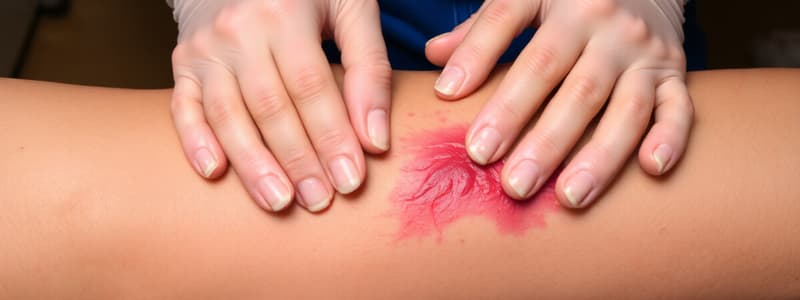Podcast
Questions and Answers
What describes a localized injury to the skin and/or underlying tissue due to pressure?
What describes a localized injury to the skin and/or underlying tissue due to pressure?
- Tissue ischemia
- Necrotizing fasciitis
- Pressure injury (correct)
- Inflammatory response
Which factor does NOT contribute to the risk of pressure injury development?
Which factor does NOT contribute to the risk of pressure injury development?
- Oxygenation
- Age
- Moisture
- Length of hospital stay (correct)
What type of wound healing involves the edges of the wound being brought together, typically with sutures?
What type of wound healing involves the edges of the wound being brought together, typically with sutures?
- Granulation intention
- Primary intention (correct)
- Secondary intention
- Tertiary intention
Which of the following factors is least likely to enhance tissue tolerance to externally applied pressure?
Which of the following factors is least likely to enhance tissue tolerance to externally applied pressure?
Which statement about shearing forces is true?
Which statement about shearing forces is true?
What is the primary purpose of using the Braden Scale?
What is the primary purpose of using the Braden Scale?
Which condition is NOT a common co-morbidity that affects wound healing?
Which condition is NOT a common co-morbidity that affects wound healing?
Which of the following factors could lead to moisture-related skin damage, increasing pressure injury risk?
Which of the following factors could lead to moisture-related skin damage, increasing pressure injury risk?
Flashcards
Pressure Injury
Pressure Injury
A localized damage to skin and underlying tissue caused by prolonged pressure.
Tissue Necrosis
Tissue Necrosis
Death of body tissue due to lack of blood flow, often caused by pressure.
Pressure Injury Cause
Pressure Injury Cause
Prolonged pressure, often over bony prominences—areas that stick out.
Contributing Factor: Shearing
Contributing Factor: Shearing
Signup and view all the flashcards
Contributing Factor: Friction
Contributing Factor: Friction
Signup and view all the flashcards
Contributing Factor: Moisture
Contributing Factor: Moisture
Signup and view all the flashcards
Braden Scale
Braden Scale
Signup and view all the flashcards
Wound Healing Intentions
Wound Healing Intentions
Signup and view all the flashcards
Study Notes
Tissue Integrity and Wound Healing
- Pressure injuries form over bony prominences in immobile patients.
- Common bony prominences include the back of the head, shoulders, elbows, lower back, hips, inner knees, and heels.
- Pressure injuries are a localized skin and/or underlying tissue damage due to pressure.
- Pressure injuries cause tissue necrosis.
- Pressure injury risk factors include length of time pressure is exerted, ability of tissue to tolerate pressure, age, density, collagen, and comorbidities.
- Shearing force is pressure exerted on the skin when it adheres to the bed linen.
- Friction is two surfaces rubbing against each other, like bed sheets and skin.
- Moisture factors include excessive diaphoresis, urine, and stool.
- Pressure injuries are graded and staged according to the depth of tissue damage, from Stage 1 (minor) to Stage 4 (severe).
- Slough is stringy, yellow dead tissue.
- Eschar is black/brown necrotic tissue.
- Blisters on the heels can be a result of pressure injury.
Nursing Problems
- Impaired tissue integrity
- Skin integrity
Unit Outcomes
- Differentiate among healing by primary, secondary, and tertiary intention.
- Describe wound healing principles.
- Explain the nursing process in caring for individuals experiencing a wound.
- Describe factors that delay healing or result in complications.
- Explain the etiology and clinical manifestations of pressure injury.
- Discuss using the Braden Scale to assess for pressure injury risk.
- Identify measures used to prevent pressure injury development.
- Explain the nursing and collaborative management of pressure injury with or without infections of the integument.
Case Study - E.A.
- 88-year-old woman with hypertension.
- Lives alone and sits in a recliner all day.
- Daughter visits daily to assist with meals and medications, and care.
- Reports "my name is EA, what time is dinner?"
- Temperature: 38.7˚C
- Skin: moist and sticky
- Pedal pulses: weak +1
- Blood pressure: 88/64
- Hemoglobin and Hematocrit are below normal range for a female.
Cue Recognition
- Advanced age
- Thin skin
- Anemia
- Elevated body temperature
- Moisture
- Impaired mobility
- Impaired circulation/perfusion
- Diastolic blood pressure <60 mmHg
- Mental deterioration
Clinical Manifestations of Pressure Ulcers
- Pressure ulcers are graded and staged based on the deepest area of tissue damage (Stage 1 to Stage 4)
- Staging may require removing slough and/or eschar.
Wound Infection
- Signs/symptoms include leukocytosis (WBC > 10,000), fever, increased ulcer size, odor, or drainage, necrotic tissue, and pain.
- Untreated ulcers can lead to cellulitis, chronic infection, sepsis, and possibly death.
Nursing Actions/Implementation
- Wound care/Prevent infection: Wound care, proper nutrition, pain relief, pressure relief
- Control co-morbidities: Treating comorbidities, such as Hypertension, reduces risks to injury.
- Infection management includes getting cultures to determine the organism and the most effective antibiotic.
- Cultures must be taken before any antibiotic is given.
- Psychological implications include concerns about scars, drainage, or odor.
Patient Teaching
- Teach signs and symptoms of infection.
- Report changes in wound color or drainage immediately.
- Provide antibiotic and analgesic teaching.
Prevention
- Remove excessive moisture
- Avoid pressure on bony prominences
- Turn and position every 1-2 hours, with care to avoid shearing.
- Use mild cleansing agents for bathing.
- Minimize irritation and dryness
- Use lift sheets when turning
Prevention - Skin Care
- Positioning: pillows, elbow, and heel protectors, pressure reducing devices.
- Specialty beds
- Lift devices
Nutrition
- Increase caloric and protein intake using wound healing diets, dietary supplements, enteral or parenteral feedings.
- Monitor weight daily.
Treatment Pressure Injury Care
- Document and describe size, stage, location, exudate, infection, pain, and tissue appearance.
- Keep ulcer bed moist
- Cleanse with nontoxic solutions
- Surgical debridement (removal of necrotic tissue).
- Dressings Maintain moisture
Debridement methods
- Surgical
- Mechanical (wet-to-dry or moist)
- Enzymatic (Panafil, Gladase, Elase)
- Autolytic (Aquacel, Comfeel, DuoDerm, Tegasorb)
Management of Wound Bed to Accelerate Healing
- Aim to convert the environment (molecular and cellular) of a chronic wound to that of an acute wound.
Types of Wound Healing
- Primary intention: clean, closed wounds (e.g., surgical incision).
- Secondary intention: wounds with significant tissue loss, large wounds that heal from the bottom up (e.g., pressure ulcers).
- Tertiary intention: wounds that are initially left open to allow for infection resolution, then closed.
Complications of Healing
- Dehiscence
- Post-op infection
- Hypertrophic scar
- Keloid scar.
- Wound measurement methods: centimeters, oriented from head to toe, side to side, and depth if appropriate.
Assessment Tools
- Braden Scale for predicting pressure ulcer risk.
- Total score of 23 possible - 18 or less indicates high risk for skin breakdown.
Assessment
- Assess pressure injury risk within 1 hour of admission and at periodic intervals.
- Document any pressure injuries present on admission.
- Patients without any injuries are reassessed every 12-24 hours, Patients requiring turning and positioning should be assessed every 2 hours, Assess skin temperature using your hands. If skin feels warm initially, then cooler.
Assessment of darker skin patients
- Look for areas of skin darker than surrounding skin.
- May appear with red, blue, or purple hues in darker skin tones
- Use natural light for accurate assessment; fluorescent light can skew results.
- Touch the skin to feel consistency; boggy or edematous tissue may indicate a pressure injury.
- Ask about pain or an itchy sensation.
Studying That Suits You
Use AI to generate personalized quizzes and flashcards to suit your learning preferences.





